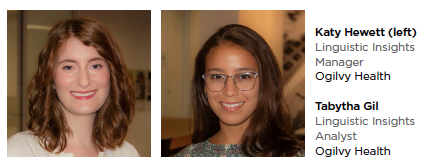 Cog fog. Brain zaps. ALKies. Patients and caregivers use unique language in their online communities. This is normal. All types of communities develop shared language and meanings over time. The true meaning of language is not fixed, but ever-evolving and co-created through common usage. Health-related language is especially susceptible to change, due to medical advances. Social listening provides a real-time view into these communities. Natural language processing (NLP) enables analysis of their language patterns, and human interpretation reveals the significance of those patterns in context.
Cog fog. Brain zaps. ALKies. Patients and caregivers use unique language in their online communities. This is normal. All types of communities develop shared language and meanings over time. The true meaning of language is not fixed, but ever-evolving and co-created through common usage. Health-related language is especially susceptible to change, due to medical advances. Social listening provides a real-time view into these communities. Natural language processing (NLP) enables analysis of their language patterns, and human interpretation reveals the significance of those patterns in context.
Why Does Analysis of Real Patient and Caregiver Language Matter?
Not only do online communities of patients and caregivers develop a shared language, they also use this language to signal their membership and demonstrate that they are connected by common experiences and knowledge. To members, this language is clear, familiar, current, and resonant. Brands can signal that they also understand these experiences by incorporating this language into their messaging.
How Can We Identify This Language?
Strategic language choice is best informed by insight into real language. Discussions among online patient and caregiver communities are a freely available and rich data source. A typical condition-based online community has thousands of posts, which is too many posts to review individually. Social listening provides easy access to this vast data source.
To understand how social listening works, it is important to understand the meaning behind this phrase: NLP. NLP is used in many ways — from voice assistants to chatbots — and the capabilities of most social listening platforms are powered in part by NLP. Thus, understanding how NLP works can help you to better contextualize and interpret insights generated by these tools.
Let’s start at the beginning: natural languages are human languages people speak which evolved, and continue to evolve, over time. The human brain is a powerful computer equipped to process and generate natural language quickly and efficiently; but processing the subtleties of natural language is difficult for machines. To help bridge this communication gap, computational linguists are continuously designing processing models to enable computers to parse and understand natural language. These models typically rely on large sets of manually tagged text, which are used to train algorithms to automatically label various linguistic and paralinguistic features (eg, sentiment, emotion, topic trends). The process of creating, testing, and refining datasets of natural text essentially allows the computer to learn through repetition and has proven to be quite successful in a variety of applications.
Why Do We Still Need Human Interpretation?
Despite the progress made in the field of NLP, we still have a long way to go. The fact is that natural language is extremely complex; humans often rely on figurative language and non-verbal cues in day-to-day communication and are perpetually co-creating new terms and meanings. NLP, in the context of health care, faces some unique challenges of which marketers should remain aware.
Consider the implications of a positive test result for a genetic mutation, where the word positive is automatically labeled as positive in sentiment. Similarly, there are often many intersecting and diametrically opposed conversations within a single disease state. For example, the digital conversation around breast cancer is vast and diverse. However, when we drill deeper specifically into the metastatic breast cancer space, we see that many patients harbor resentment and distaste for traditional messaging that restricts the breast cancer discussion to female anatomy; thereby, excluding both women who have had mastectomies and male patients with breast cancer. These types of limitations highlight the importance of human interpretation of NLP insights.
As healthcare marketers, it is to our benefit to speak the authentic language of patients and caregivers, and it is our responsibility to ensure we identify this language strategically and discerningly. Automated insights generated through social listening are not valueless — in fact, they provide a great starting point for healthcare marketers to understand language through the utilization of big data. However, NLP is far from objective, and the process by which it runs is not perfect and probably never will be. Thus, it is essential for healthcare marketers to remain critical, curious, and unafraid to dig a little deeper.(PV)
Ogilvy Health makes brands matter by keeping our audiences’ health, healthcare and wellness needs at the center of every touchpoint.
For more information, visit ogilvyhealth.com.
For more information, visit ogilvychww.com.








